Amazon recently announced a partnership with Morrisons to add an online grocery shopping service to their vast repertoire, with the service Amazon Pantry. Already available in many US cities where the service is named “Amazon Fresh” this eCommerce giant’s expansion into the grocery market online, may have got you thinking about the opportunities for food eCommerce brands…
Last year online sales accounted for 6% of grocery sales and the category grew by 9% year on year at a time when the wider market was in decline.1
Why do consumers want to buy food and beverages online?

Image source: The Hartman Group, Inc, The Online Grocery Shopper Report
Research by The Hartman Group2 says some of the main drivers for shopping for groceries online include:
- Saving time
- Saving money
- Saving driving and gas
- To order in bulk
A common theme here is definitely convenience. We have seen how the condition of the modern consumer – low on time and high on cash has led to more brands building immediacy and convenience into their product, often by taking this offering online.
Across different demographic groups, these needs and desires are of course changing, particularly with age, as those who learnt how to navigate the internet work to catch up to those who were raised on it.
Percentage using/willing to use home delivery or automatic subscriptions
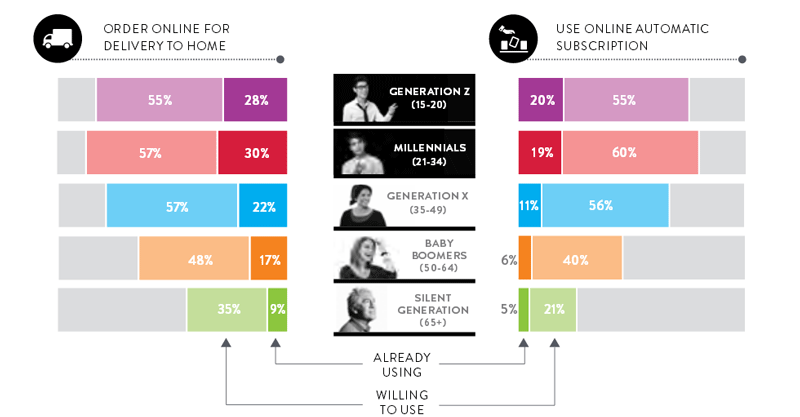
Image source: Nielsen, The Future of Grocery
The above research from Nielsen3 shows that Millenials and Generation Z are by far the most active and willing to use online ordering for home delivery and subscription services.
Percentage using/willing to use a virtual supermarket or in-store pick up
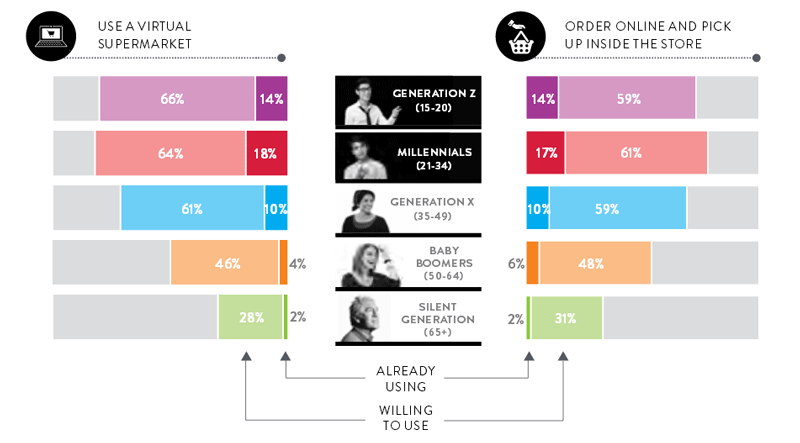
Image source: Nielsen, The Future of Grocery
It’s a similar story with virtual supermarkets (more about these in a moment) and click and collect purchases with Millenials leading the way. Where older demographics may prefer to go in-store to experience and choose their products, Millenials and Generation Z expect to be offered an online option that will provide them with convenience.
Who’s already purchased food or groceries online by demographic?
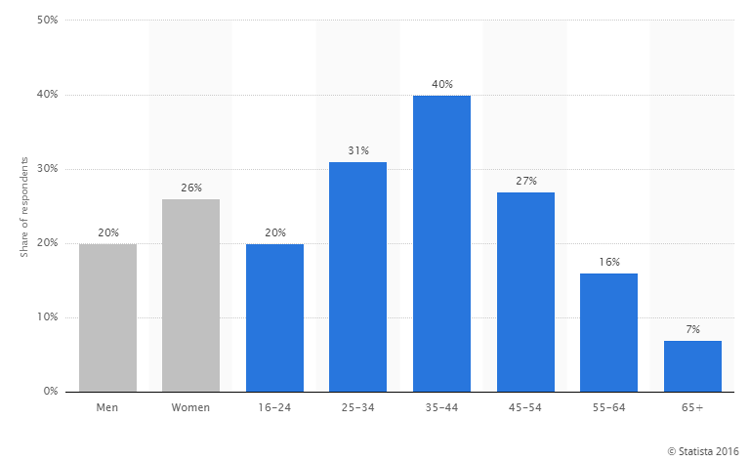
Image source: Statista 2016
Other research by Statista that directly looked at who purchased food or groceries online in Great Britain in 2015 by age and gender. This shows that Generation X are the most active online grocery shoppers with 40% of individuals surveyed in this group having made purchases in 2015. This makes sense as Generation X are likely to be in command of a family household budget and are balancing work and family commitments. Additionally, slightly more women were shown to have purchased groceries online than men.4
Why niche and specialist food and beverage products (particularly health) excel online
Shelf space is a premium for supermarkets and should be earning money. For a supermarket to justify putting a product on it’s shelves over another, it needs to know there’s public demand. This leads to a product offering which can never truly be as deep as an eCommerce retailer.
Demographic groups tastes are diverging and in what some are calling “the age of the individual”, consumers’ don’t want to be like everyone else, they want a product that perfectly suits them, making “niche” much more “specialist” than before.
Additionally the same research by Neilsen shows a large consumer appetite for fresh, natural and minimally processed foods that promote good health.3
Click and collect, virtual supermarkets or home delivery, the choice is theirs
Virtual supermarkets have seen great success, particularly in South Korea where hard working commuters can turn “waiting time” on train platforms into productive shopping time, scanning outdoor advertising posters to add items to their shopping cart.
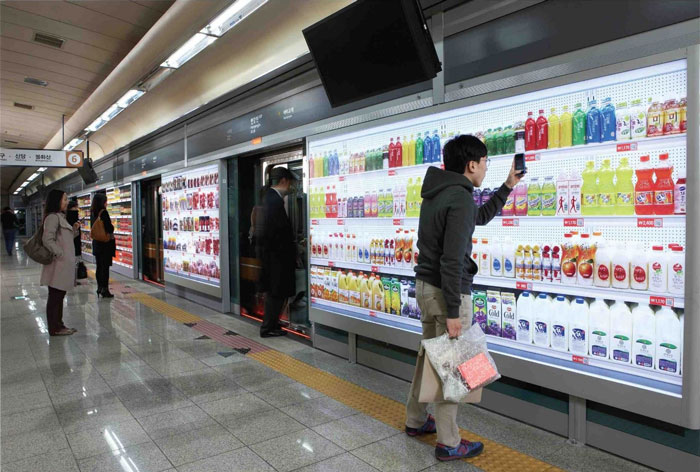
Image source: http://pioneeringooh.com/tescos-subway-virtual-store/
This is just one of the many ways that retailers can make merchandising more agile and allow the consumer to shop on the terms that best suit their individual needs.
Offer consumers a smooth delivery process which includes as many delivery options as possible, such as click and collect, cubrside pick up and home delivery.
Caution: logistics ahead
One of the main reasons consumers go online for food and drink is for convenience, so make sure that you’ve got a great partner in fulfilment. Because consumers are putting a lot of trust in your brand to help with the important matter of food and drink, one broken carton of yoghurt or a late order of dinner supplies will greatly damage the customer relationship with your brand.
Asda CEO Andy Clarke cites customer experience as the main area where supermarkets such as Asda can compete with online retailers like Amazon.
“The most consistent feedback we get on the store experience is to make life as easy as possible,” said Clarke “Don’t deliver things I don’t want. Don’t make substitutions that are inappropriate or don’t make sense for me and my family”.5
Subscription services, so hot right now
One area where food and beverage eCommerce business has flourished is the subscription model. Graze managed to go from 0 to 80,000 subscribers in the first 6 months of launching6, thanks to harnessing the power of network marketing. By asking customers to recommend the product to their friends, social media has become a key marketing tool for the brand.
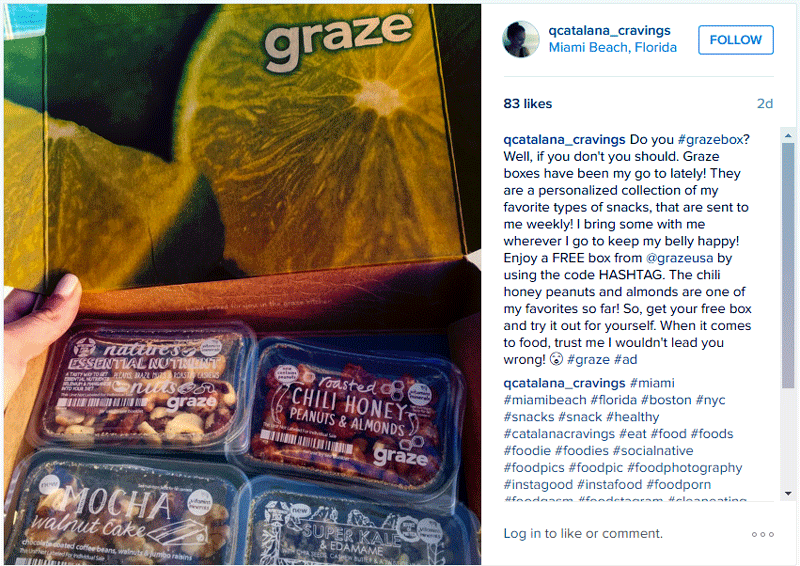
Image source: https://www.instagram.com/qcatalana_cravings/

Image source: https://twitter.com/m0rdsith/status/706875705255186432
Subscriptions services have tapped into the popular consumer trend of wanting to live a healthy lifestyle whilst being short on time. This modern condition is at the forefront of food and beverage trends. A number of services seem to offer a healthy option delivered right to you door. Whether it’s Diet Chef offering pre-made healthy meals, Abel & Cole providing seasonal fruits and vegetables to cut out the hassle of shopping or Hello Fresh which lets consumers keep the control of cooking their own food but provides them with the convenience of delivering the ingredients and recipe.
In summary
Online can’t compete at the moment with the immediacy that “nipping to the shops” will provide, but there are some real opportunities online for the food and beverage industry. The consumer is hungry for an eCommerce food and drink offering that suits their lifestyle.
We’ve put together a handy SWOT overview for the food and drink industry online, to summarise the key points:
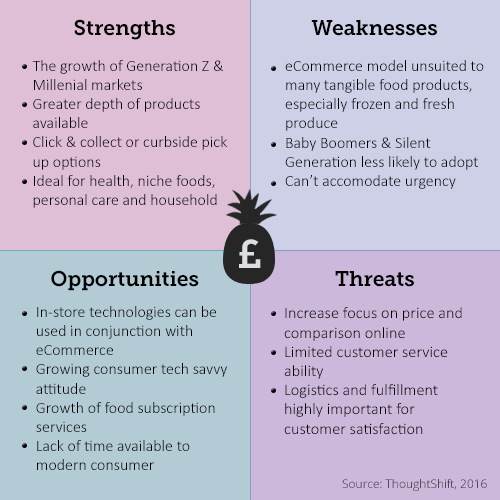
Thanks for reading
If you liked this post about food and drink industry trends and stats, follow my contributions to the blog for more on the latest trends in consumer behaviour. Or sign up to our guest list email and never miss a thing…
Sources
- The Guardian
- The Hartman Group
- Nielsen
- Statista
- Marketing Magazine
- eConsultancy






